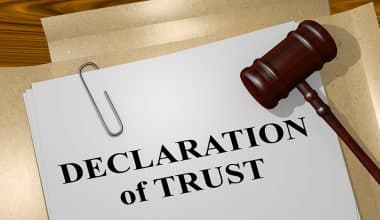When it comes to buying a home, coming up with a down payment might be difficult, especially if you want to put down 20% to avoid paying for private mortgage insurance. If you can’t afford a large down payment, a piggyback loan can be a viable alternative for you. However, these loans come with their own set of prices and drawbacks. Here’s what you should know about a piggyback mortgage loan, the lenders, how to refinance them, and their alternatives.
What is a Piggyback Loan?
A piggyback loan consists of obtaining two mortgages, one large and one little. The smaller mortgage “hides” behind the larger one. A traditional mortgage is a primary loan. The other option is a home equity loan or line of credit.
The primary rationale for getting a piggyback loan is to avoid paying for private mortgage insurance.
How Does a Piggyback Loan Work?
A piggyback loan operates as follows: You obtain a mortgage for the standard amount of 80% of the home’s buying price. Instead of paying the remaining 20% in cash for a down payment, you take out a second loan (usually at 10%) and then put the remaining 10% down with cash.
Assume you want to buy a $200,000 home but only have $20,000 in savings. Using the piggyback loan technique, you would obtain a $160,000 mortgage (80 percent ). Then you would take out a $20,000 piggyback loan (10 percent ). Finally, you would pay the remaining $20,000 (10%) as a down payment.
You use this approach to obtain both loans at the same time. The second smaller loan, typically a home equity loan or line of credit (HELOC) with a 10-year draw period, supplements the first to satisfy your total borrowing needs.
However, you are not required to obtain both loans from the same lender. If you notify your primary mortgage lender that you intend to use a piggyback loan, they will recommend you to a second lender who can provide the additional financing.
Types of Piggyback Loan
There are several types of piggyback loans:
Getting a second mortgage: A standard piggyback loan has two mortgages. That means two different sets of closing expenses and terms. It may even be necessary to use two distinct piggyback loan lenders.
- Property equity loan: If you currently live in a home that you’ve paid off (or significantly reduced with your mortgage), you can apply for a home equity loan, which is a lump sum of cash that you can put on the back of a mortgage for up to 80% of the purchase price.
- HELOC: A HELOC is similar to a home equity loan, except that the interest rate on a HELOC is variable, so your monthly payments will fluctuate, and you will draw down cash rather than withdrawing a large sum all at once.
Why It Might Be Difficult to Get a Piggyback Loan
In theory, a piggyback loan appears to be the superior alternative, but there are dangers, therefore the lender will require proof that you can handle the additional debt.
One thing to bear in mind is that the mortgage lender will consider your debt-to-income (DTI) ratio when approving your loan. Because you’re effectively taking out two loans for a property, you’re incurring more debt, therefore you’ll need a greater salary to cover both.
Your DTI should not exceed 28 percent, which means that the total monthly cost of both of your loans cannot exceed 28 percent of your gross monthly income. If your monthly pre-tax income is $6,000, for example, you will not be eligible for a piggyback loan that costs more than $1,680 a month.
Furthermore, because taking on two distinct loans at the same time is dangerous, you’ll need good credit to qualify for a piggyback loan. Each lender has various requirements, but a credit score of at least 680 is required.
Advantages of Piggyback Loans
#1. PMI Avoidance
One of the most typical reasons for obtaining a piggyback loan is to avoid paying private mortgage insurance (PMI), which protects the lender in the event of a default. Getting two mortgages is less expensive for the homeowner, and the interest is frequently tax deductible. Before making such a significant financial choice, we recommend consulting with your tax professional.
When you have 20% or more equity in your house, you have the legal right to request that your lender discontinue your PMI. Otherwise, the lender is required to discontinue PMI once you have achieved 22 percent equity in your property.
#2. Reduced Down Payments
A piggyback mortgage can also be used to finance more than 80% of the buying price of a home (also referred to as 80 percent loan-to-value or LTV).
For example, if a property buyer only has enough money for a 5% down payment, they can acquire an 80/15/5 loan. The “80” refers to the initial mortgage, which finances the first 80% of the purchase price of the home. The “15” refers to the second mortgage, which funds the remaining 15% of the purchase price. The “5” represents the borrower’s 5% down payment.
This can be done in two ways: 80/15/5 or 80/10/10. Some piggyback loan lenders, however, provide an 80/20 option in which the second mortgage covers the remainder of the purchase price with no down payment.
#3. Convenience
A piggyback loan can be a useful tool for property buyers. Because a piggyback mortgage closes at the same time as the initial mortgage, there is no need to attend two closings, sign two sets of paperwork, or pay two different closing charges. If your original lender does not offer piggyback loans, they will most likely propose another lender with whom they have a working connection.
The second loan can sometimes be structured in such a way that the homeowner can benefit from it. For example, if the second loan is a home equity line of credit, the homeowner can use the loan for house upgrades.
Piggyback loans can also be designed to accept simple interest payments. This means that you only have to pay the interest for a set length of time, but you can add as much principal as you like on top of that.
This option gives homeowners more options for how they can spend their money. They may put it into their 401(k) or other financial investments, pay off high-interest credit card debt, or preserve it for a rainy day.
#4. Keeping Jumbo Loan Interest Rates at a Minimum
If you’re looking for more expensive property, a piggyback loan may allow you to sidestep the lending constraints of jumbo loans. Lower interest rates on the first mortgage will benefit you.
The Drawbacks of Piggyback Loan
On the other hand, piggyback mortgages have a number of disadvantages that can turn off a borrower. Here are a few examples:
#1. Higher interest rates:
Because the second mortgage is related to short-term interest rates, it is typically financed at a higher mortgage rate than the primary mortgage. In fact, these rates may eventually outweigh the expense of PMI.
#2. Higher monthly payments:
Second mortgages are often restricted to primary residences and have a shorter loan period than first mortgages. This means higher monthly mortgage payments and restrictions on the type of house.
#3. Amount restrictions:
Second mortgages are similarly restricted to loan amounts of no more than $100,000. Some piggyback loan lenders, however, allow for more. Piggyback loans are not available from other lenders, such as Rocket Mortgage®.
Requirements for a Piggyback Loan
The conditions and loan terms differ from lender to lender. However, the majority of lenders who offer this type of program follow several of the same standards. Keep in mind that the standards listed below are not binding on any particular lender, but you should expect the following:
- A borrower must normally meet all of the same requirements as a conventional loan. This includes at least two years of satisfactory job history, no serious credit concerns, and reserve restrictions imposed by some lenders (a certain amount of liquid savings).
- A credit score of 680 or above is required. You might locate a lender who will make an exception, but we are not aware of any mortgage lender who will take a lower credit score.
- You will be required to make a down payment. The amount necessary is determined by the piggyback loan program for which you apply. On an 80/10/10 program, you should anticipate having to pay down 10%. You will need to put down 5% on an 80/15/5 program.
Best Piggyback Loan Lenders In 2023
All of the mortgage lenders listed below provide a piggyback loan in addition to typical mortgages such as FHA, USDA, and conventional loans. We recommend speaking with one of these firms’ expert loan specialists who can assist you in making an informed selection.
- Alpine Banker
- Bluewater Mortgage
- Northstar Capital
- Arcus Lending
- First Castle Federal Credit Union
- Wholesale Capital Corporation
- Citywide Mortgages
How Does a Piggyback Loan Help to Remove PMI?
Piggyback loan lenders frequently mandate private mortgage insurance (PMI) if the down payment on the loan is less than 20%. In some situations, a piggyback mortgage can be used to come up with the down payment capital to alleviate this need. It should be noted that each loan may include terms or restrictions that preclude it from being used in this manner.
Is a Junior or Senior Loan a Piggyback Mortgage?
A piggyback mortgage is a junior loan that is subordinate to the senior loan, the primary mortgage. Junior mortgages frequently have higher interest rates, are limited to smaller loan amounts, and may be subject to additional imitations.
How Can You Refinance a Piggyback Loan?
You may be wondering, “Will I be able to refinance if I acquire a piggyback loan?”
Yes, however refinancing with a second mortgage is a little more difficult.
When you refinance a piggyback loan, you may be able to pay off the second mortgage. You might combine two mortgage loans into one in this manner, effectively lowering your interest rate and total interest paid.
This will not be considered a cash-out refinance as long as you can demonstrate that you used the entire second mortgage to acquire your house. This means you can benefit from lower rates.
When you refinance a piggyback loan, you must ensure that you have enough equity in your house to pay down any outstanding balance on the second mortgage.
You can refinance your piggyback loan to combine both debts into one, or you can refinance simply the first mortgage and leave the second lien alone.
The second option is to refinance only the principal mortgage and leave the second lien (the “piggyback loan”) alone.
You’ll need to engage with the lender who owns your second mortgage to accomplish this. It must agree to take a back seat to your newly refinanced mortgage. This is referred to as a “subordination agreement.”
Overall, you should not be prevented from refinancing your piggyback loan at a reduced interest rate in the future. However, be aware that there will be more hoops to jump through.
Piggyback Loan Alternatives
Piggyback loans were typical before several low-down-payment mortgage schemes became popular, according to McBride. If you’re worried about that 20% down payment, there are a variety of first-time homebuyer loans and grants available to assist you to move into a home with less upfront money and without the added layer of a piggyback loan:
#1. FHA loan
An FHA loan, backed by the Federal Housing Administration, allows you to put down as little as 3.5 percent for a property. You can also get this loan if you have bad credit. For the 3.5 percent down payment, the program demands a minimum credit score of 580. If your credit score is between 500 and 579, you must put down 10%.
#2. Conventional 97
Fannie Mae and Freddie Mac, two government-sponsored corporations, assist in making mortgages available with as little as 3% down.
#3. VA loan
If you’ve been or are currently serving in the military, you may be qualified for a loan backed by the United States Department of Veterans Affairs, and you don’t have to put any money down.
You’ll be able to write a smaller check with a low-down payment program, but depending on your lender, you may also be expected to increase your home-buying knowledge. For example, Bank of America’s low-down payment loan program requires borrowers to take homebuyer education classes. Investing a few hours of your time, on the other hand, is a little amount to pay to be able to afford your own place.
Can a House Have Two Loans on It?
When you obtain two distinct loans for the same property, this is known as a piggyback mortgage. In most cases, the first loan is for 80% of the value of the house, and the second loan is for 10%. You are responsible for paying the down payment of the remaining 10%.
How Can I Apply for a Personal Loan?
How can I apply for a personal loan?
A personal loan can be obtained from a bank, credit union, credit card company, or online lender. You must typically give some basic personal and financial information when applying in person or online.
What Else Do You Call a Piggyback Loan?
A piggyback loan, also known as an 80/10/10 or combination mortgage, is taking out two mortgages at once, one for 80% of the home’s purchase price and another for 10%, with your own cash for a down payment covering the final 10%.
In Banking, What Does the Term “Piggyback” Mean?
When someone piggybacks on another person’s credit card, they do it with the intention of raising their credit score. This is not the same thing as having a joint account.
What Loan Can I Be Approved for the Quickest?
Payday loans, auto title loans, pawnshop loans, and no credit check personal loans are the loans that are the simplest to be approved for. These loans are accessible to those with bad credit because they provide immediate money and have few conditions.
Piggyback Loan FAQs
How hard is it to get a piggyback loan?
While piggyback mortgages are becoming more prevalent, they are far from straightforward to obtain. To qualify, you’ll most likely need a credit score in the very good (740-799) or exceptional (800-850) FICO areas. Furthermore, you must apply for and be approved for both loans individually.
Do piggyback loans still exist?
Some may be shocked that piggyback loans are still available in 2023. Not only do they exist, but multiple mortgage lenders provide these types of loans.
How do you qualify for a piggyback loan?
Piggyback mortgages frequently necessitate a high credit score. You will most likely need a 680 credit score to qualify, although this can vary depending on the lender. Borrowers with less-than-perfect credit, an inconsistent income history, or who are using a gift for the 10% down payment will most likely require FHA.
- What Is Mortgage Insurance and When Do You Need It?
- MORTGAGE RATES FOR INVESTMENT PROPERTY: Current Mortgage Rates for Investment Property
- Secondary Mortgage Market: Step By Step Guide On How It Works
- SECOND MORTGAGE: Definition, Rates and Requirements
- What Is Mortgage Insurance Premium? How It Works
- HOW TO GET RID OF PMI: How Easily Can I Get Rid of My PMI






